医学论文英文摘要写作技巧
- 格式:doc
- 大小:50.50 KB
- 文档页数:6
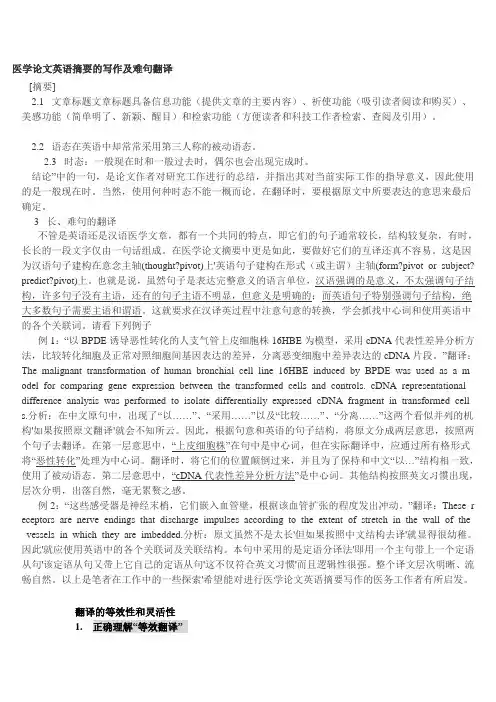
医学论文英语摘要的写作及难句翻译[摘要]2.1 文章标题文章标题具备信息功能(提供文章的主要内容)、祈使功能(吸引读者阅读和购买)、美感功能(简单明了、新颖、醒目)和检索功能(方便读者和科技工作者检索、查阅及引用)。
2.2 语态在英语中却常常采用第三人称的被动语态。
2.3 时态:一般现在时和一般过去时,偶尔也会出现完成时。
结论”中的一句,是论文作者对研究工作进行的总结,并指出其对当前实际工作的指导意义,因此使用的是一般现在时。
当然,使用何种时态不能一概而论。
在翻译时,要根据原文中所要表达的意思来最后确定。
3 长、难句的翻译不管是英语还是汉语医学文章,都有一个共同的特点,即它们的句子通常较长,结构较复杂,有时,长长的一段文字仅由一句话组成。
在医学论文摘要中更是如此,要做好它们的互译还真不容易。
这是因为汉语句子建构在意念主轴(thought?pivot)上'英语句子建构在形式(或主谓)主轴(form?pivot or subject? predict?pivot)上。
也就是说,虽然句子是表达完整意义的语言单位,汉语强调的是意义,不太强调句子结构,许多句子没有主语,还有的句子主语不明显,但意义是明确的;而英语句子特别强调句子结构,绝大多数句子需要主语和谓语。
这就要求在汉译英过程中注意句意的转换,学会抓找中心词和使用英语中的各个关联词。
请看下列例子例1:“以BPDE诱导恶性转化的人支气管上皮细胞株16HBE为模型,采用cDNA代表性差异分析方法,比较转化细胞及正常对照细胞间基因表达的差异,分离恶变细胞中差异表达的cDNA片段。
”翻译:The malignant transformation of human bronchial cell line 16HBE induced by BPDE was used as a m odel for comparing gene expression between the transformed cells and controls. cDNA representational difference analysis was performed to isolate differentially expressed cDNA fragment in transformed cell s.分析:在中文原句中,出现了“以……”、“采用……”以及“比较……”、“分离……”这两个看似并列的机构'如果按照原文翻译'就会不知所云。
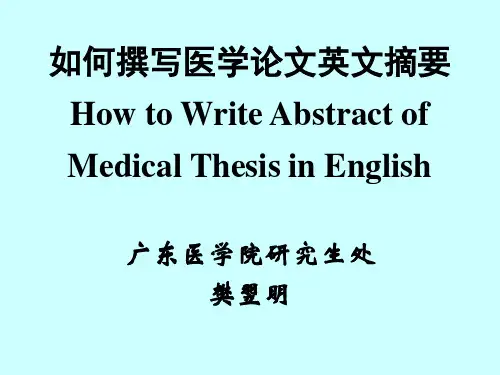
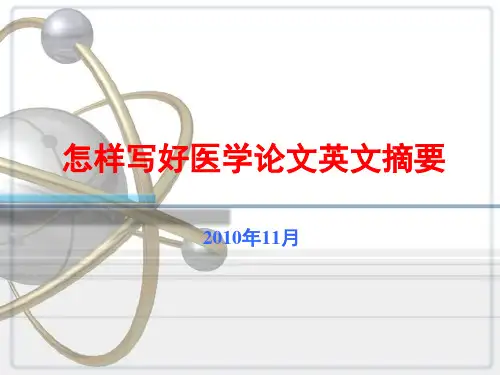
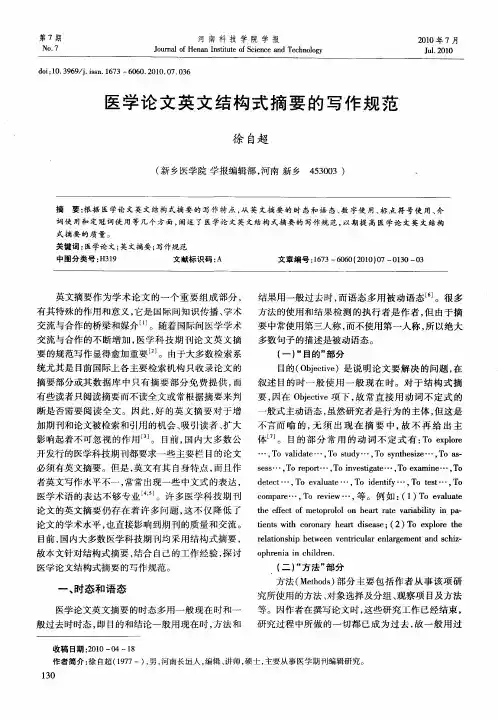
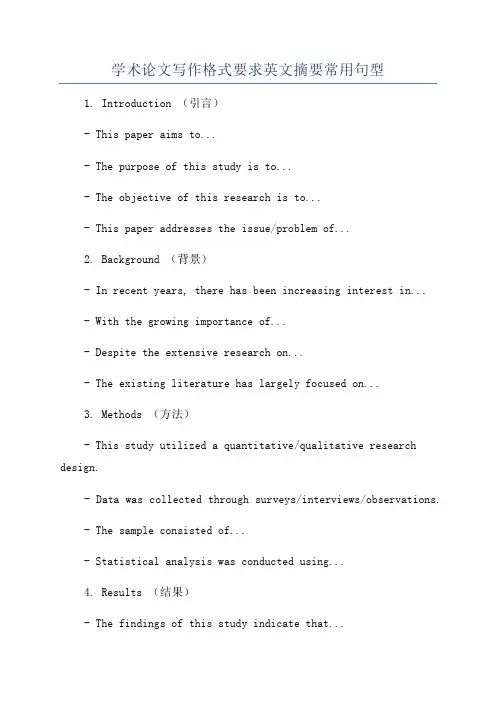
学术论文写作格式要求英文摘要常用句型1. Introduction (引言)- This paper aims to...- The purpose of this study is to...- The objective of this research is to...- This paper addresses the issue/problem of...2. Background (背景)- In recent years, there has been increasing interest in...- With the growing importance of...- Despite the extensive research on...- The existing literature has largely focused on...3. Methods (方法)- This study utilized a quantitative/qualitative research design.- Data was collected through surveys/interviews/observations.- The sample consisted of...- Statistical analysis was conducted using...4. Results (结果)- The findings of this study indicate that...- The results suggest that...- The analysis revealed that...- There is a significant correlation between...5. Discussion (讨论)- These results provide insights into...- The implications of these findings are discussed in terms of...- The present study contributes to the understanding of...- These findings are consistent with previous research in the field of...6. Conclusion (结论)- In conclusion, this study highlights the importance of...- Based on the findings, it can be concluded that...- This study provides valuable information for...- Further research is needed to explore...7. Limitations (限制)- Although this study has provided significant insights, it is not without limitations.- One limitation of this study is the small sample size.- Another limitation is the reliance on self-reported data.- Future research should address these limitations by...8. Implications (意义)- The findings of this study have practical implications for...- These results have important implications for policymakers/practitioners.- The implications of this study extend beyond the specific context of...- This research contributes to the theoretical understanding of...9. Future Directions (未来方向)- Future research should explore...- Further investigation is needed to determine...- Future studies could examine...- This research sets the stage for future research on...。
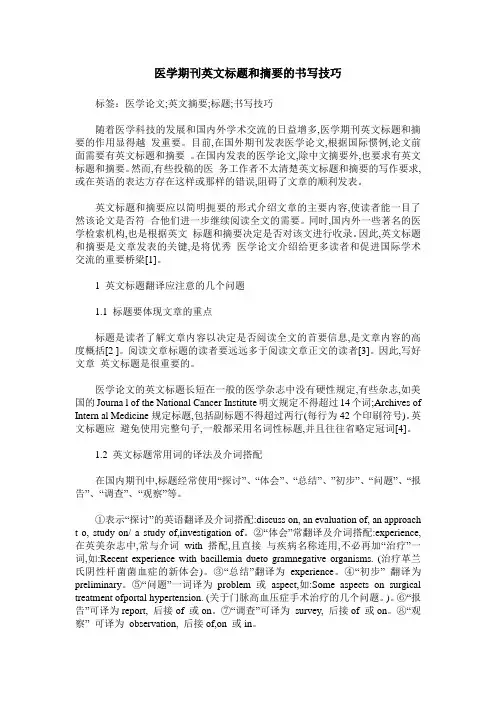
医学期刊英文标题和摘要的书写技巧标签:医学论文;英文摘要;标题;书写技巧随着医学科技的发展和国内外学术交流的日益增多,医学期刊英文标题和摘要的作用显得越发重要。
目前,在国外期刊发表医学论文,根据国际惯例,论文前面需要有英文标题和摘要。
在国内发表的医学论文,除中文摘要外,也要求有英文标题和摘要。
然而,有些投稿的医务工作者不太清楚英文标题和摘要的写作要求,或在英语的表达方存在这样或那样的错误,阻碍了文章的顺利发表。
英文标题和摘要应以简明扼要的形式介绍文章的主要内容,使读者能一目了然该论文是否符合他们进一步继续阅读全文的需要。
同时,国内外一些著名的医学检索机构,也是根据英文标题和摘要决定是否对该文进行收录。
因此,英文标题和摘要是文章发表的关键,是将优秀医学论文介绍给更多读者和促进国际学术交流的重要桥梁[1]。
1 英文标题翻译应注意的几个问题1.1 标题要体现文章的重点标题是读者了解文章内容以决定是否阅读全文的首要信息,是文章内容的高度概括[2 ]。
阅读文章标题的读者要远远多于阅读文章正文的读者[3]。
因此,写好文章英文标题是很重要的。
医学论文的英文标题长短在一般的医学杂志中没有硬性规定,有些杂志,如美国的Journa l of the National Cancer Institute明文规定不得超过14个词;Archives of Intern al Medicine规定标题,包括副标题不得超过两行(每行为42个印刷符号)。
英文标题应避免使用完整句子,一般都采用名词性标题,并且往往省略定冠词[4]。
1.2 英文标题常用词的译法及介词搭配在国内期刊中,标题经常使用“探讨”、“体会”、“总结”、”初步”、“问题”、“报告”、“调查”、“观察”等。
①表示“探讨”的英语翻译及介词搭配:discuss on, an evaluation of, an approach t o, study on/ a study of,investigation of。
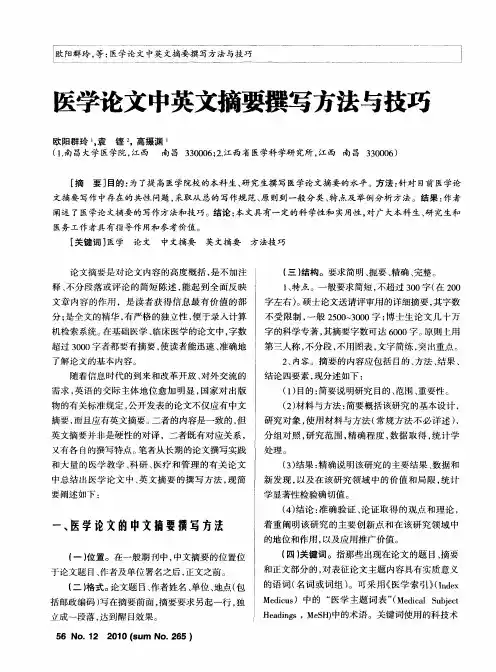
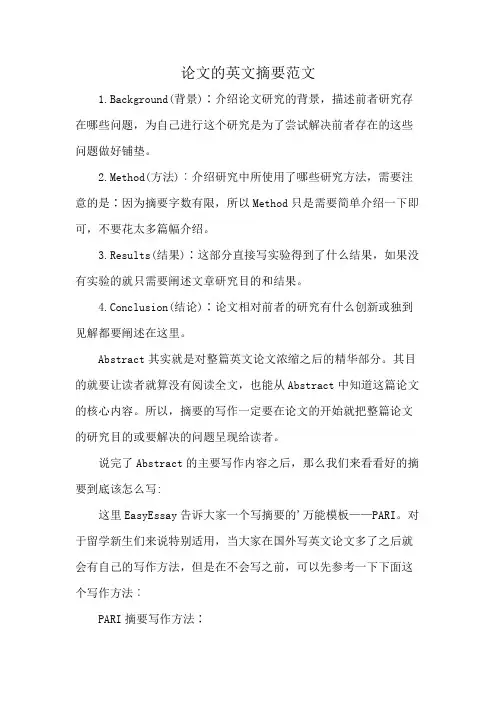
论文的英文摘要范文
1.Background(背景)∶介绍论文研究的背景,描述前者研究存在哪些问题,为自己进行这个研究是为了尝试解决前者存在的这些问题做好铺垫。
2.Method(方法)︰介绍研究中所使用了哪些研究方法,需要注意的是∶因为摘要字数有限,所以Method只是需要简单介绍一下即可,不要花太多篇幅介绍。
3.Results(结果)∶这部分直接写实验得到了什么结果,如果没有实验的就只需要阐述文章研究目的和结果。
4.Conclusion(结论)∶论文相对前者的研究有什么创新或独到见解都要阐述在这里。
Abstract其实就是对整篇英文论文浓缩之后的精华部分。
其目的就要让读者就算没有阅读全文,也能从Abstract中知道这篇论文的核心内容。
所以,摘要的写作一定要在论文的开始就把整篇论文的研究目的或要解决的问题呈现给读者。
说完了Abstract的主要写作内容之后,那么我们来看看好的摘要到底该怎么写:
这里EasyEssay告诉大家一个写摘要的'万能模板——PARI。
对于留学新生们来说特别适用,当大家在国外写英文论文多了之后就会有自己的写作方法,但是在不会写之前,可以先参考一下下面这个写作方法︰
PARI摘要写作方法∶
P=Problem:提出文章需要解决哪些问题
A=Approach:解决提出的问题是用的什么方法
R=Results:解决了提出的问题之后得到了什么结果l=lmpacts:这些结果有什么具体或者实际的影响。

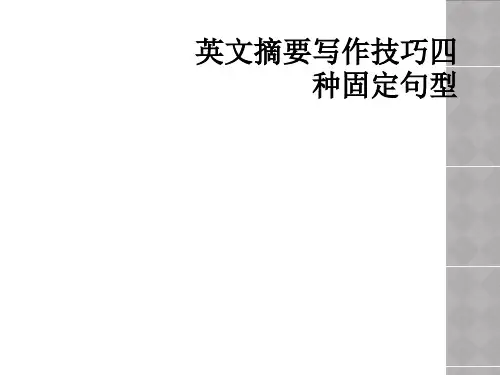
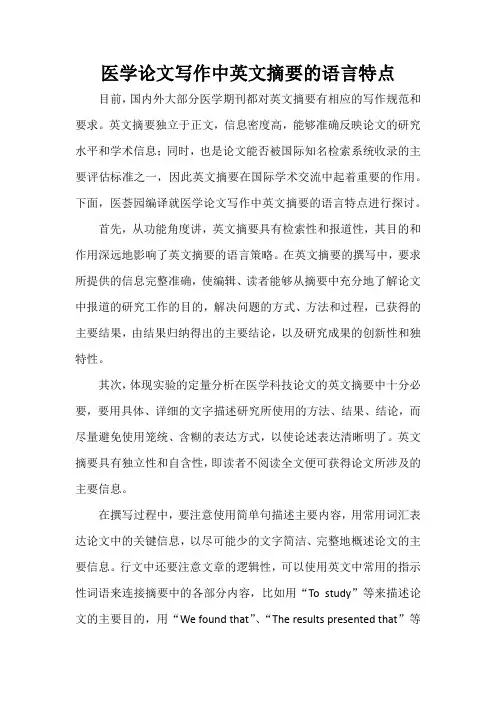
医学论文写作中英文摘要的语言特点目前,国内外大部分医学期刊都对英文摘要有相应的写作规范和要求。
英文摘要独立于正文,信息密度高,能够准确反映论文的研究水平和学术信息;同时,也是论文能否被国际知名检索系统收录的主要评估标准之一,因此英文摘要在国际学术交流中起着重要的作用。
下面,医荟园编译就医学论文写作中英文摘要的语言特点进行探讨。
首先,从功能角度讲,英文摘要具有检索性和报道性,其目的和作用深远地影响了英文摘要的语言策略。
在英文摘要的撰写中,要求所提供的信息完整准确,使编辑、读者能够从摘要中充分地了解论文中报道的研究工作的目的,解决问题的方式、方法和过程,已获得的主要结果,由结果归纳得出的主要结论,以及研究成果的创新性和独特性。
其次,体现实验的定量分析在医学科技论文的英文摘要中十分必要,要用具体、详细的文字描述研究所使用的方法、结果、结论,而尽量避免使用笼统、含糊的表达方式,以使论述表达清晰明了。
英文摘要具有独立性和自含性,即读者不阅读全文便可获得论文所涉及的主要信息。
在撰写过程中,要注意使用简单句描述主要内容,用常用词汇表达论文中的关键信息,以尽可能少的文字简洁、完整地概述论文的主要信息。
行文中还要注意文章的逻辑性,可以使用英文中常用的指示性词语来连接摘要中的各部分内容,比如用“To study”等来描述论文的主要目的,用“We found that”、“The results presented that”等来表达论文的主要结果,用“We conclude that”来介绍论文的结论。
第三,英文摘要中还要避免希腊字母、化学式、特殊字符等,涉及的指标单位也应适当简化,表述要使用标准英语,不可使用俚语、网络用语等,这种情况在作者使用翻译软件撰写英文摘要过程中较为常见。
同时,要保证语义上的准确性、无明显的感情色彩和叙述的客观性。
此外,在整个英文摘要中,要保持全文语体风格一致,尽量做到全英式或全美式。
如何发表医学SCI论文写作及技巧英文医学论文(medical papers)的定义医学论文是对整理和发表医学研究成果的一种特殊文本的总称,就其内容和文体特点而言科分为以下几种:1.医学科研论文(scientific papers)2.调查报告(survey)3.综述(review)4.学位论文(theses)5.医学科研论文(scientific papers)医学科研论文定义国际生物学编辑委员会对医学科研论文的定义为:必须是首次公布的应提供足够的资料,使同行们能够进行:①评价所观察到的结果;②评价其推理过程;③重复实验。
分为以下两种:①临床研究(clinical study);②基础研究或实验研究(experimental study)医学科研论文的格式(1)标题(title)(2)摘要(abstract)(3)引言(introduction)(4)材料和方法(materials and methods)(5)结果(results)(6)讨论(discussion)(7)致谢(acknowledgement)(8)参考文献(references)一、标题(一)要求1.简明扼要(short and concise)(1)尽量控制在一行,但不是一个句子(2)不超过25个单词或120-140个字母(3)除DNA、RNA、CT等不用缩写2.信息丰富(informative)3.便于索引(indexing)4.较长标题可采用副标题(二)标题写作中常用词组和表达方式1.用…(方法/手段)对…进行研究/分析/观察/评价:Study(analysis/observation/evaluation/assessment) of (on) …(by) using 方法/with工具)2.A对B的作用Effort of A on BProtective effect of omeprazole on endothelin-induced gastric mucosal injury3.A与B的关系Correlation (relation/relationship) between A and BCorrelation of A with B and C常用修饰词:positively/negatively/significantly/insignificantly4.用…治疗…Use of …in the treatment of …(病)in …(生物)Use of omeprazole in the treatment of gastric ulcer in the elderly5.A是B A as B二、著录部分书写(一)姓名标准式:WANG aobang,HUANG aobang,GUO Xiao’an (二)地址800 Xiang Yin Road, Shanghai 200433, P.R.China(三)资助A project funded by the National “863” Program三、摘要的分类与格式摘要是作者要给读者的精华,分两大类:(一)指示性摘要(二)资料性摘要1.非结构式摘要缺点:段落不明,给编辑、审稿、阅读和计算机处理带来诸多不便2.全结构式摘要(8要素摘要)(1)目的(2)设计(3)地点(4)对象(5)处理(6)主要测定项目(7)结果(8)结论全结构式摘要的优点(1)观点更明确(2)信息量更大(3)差错更少(4)符合计算机数据库建立和使用的要求全结构式摘要的缺点:烦琐、重复、篇幅过长3.半结构式摘要(四要素摘要)(1)目的(objective/purpose/aim)(2)方法(methods)(3)结果(results)(4)结论(conclusion)目的:是作者想要介绍的关键问题一、目的格式(一)单表目的(二)背景+目的二、目的常用时态(一)背景:现在时(一般现在时、完成时和进行时)(二)目的:一般现在时/现在完成时,或一般过去时举例:(1)To evaluate the effects on 24-hour intragastric pH levels of infusions with omeprazole and H2 receptor antagonists in bleeding duodenal ulcer patients.(2)The role of omeprazole in triple therapy and the impact of Helicobacter pylori resistance on treatment outcome are not established. This study investigated the role of omeprazole and influence of primary H. pylori resistance on eradication and development of secondary resistance.三、介绍目的常用句型主要用动词不定式to表达1.直接用to do短语表达举例:To determine if use of omeprazole protects against the gastric mucosal injury2.The purpose/aim/objective/goal(of present study is)was to举例:The aim of this study was to determine the protective function of omeprazole on gastric mucosal injury3.The present study is /was designed/devised/intended to举例:The present study was designed to establish whether there might be a genetic predisposition to an altered pattern of anti-inflammatory cytokine produced in patients with irritable bowel syndrome4.This study was performed/conducted/carried out/undertaken to举例:An experimental study was conducted using a canine mode toelucidate …5.We aimed/sought to/attempted to举例:We sought to assess whether there is an increased risk of tuberculosis among individuals who work in certain industries occupations.四、介绍目的常用动词1.研究:study, investigate, examine, observe, explore举例:Our objective in this report is to examine the clinical feature, pathology and treatment for patients with pancreatic cancer.2.评价:evaluate, validate举例:To evaluate sonography as a tool for initial diagnosis in emergency room patients with abdominal trauma.3.确定:determine, decide, confirm, support, define, characterize4.证实:prove, demonstrate, document, test, support, testify, verify5.阐明、搞清:explain, elucidate, clarify, illustrate, delineate, find out, contribute to the knowledge of6.介绍:describe, present, report7.建立:establish, develop, set out8.寻找:search for, look for, seek, find9.识别、区分:identify, differentiate, discriminate10.优选:optimize11.比较:compare12.回顾:review13.相关:correlate A with B方法部分(1)研究设计(2)研究对象的特性(3)干预或处理方法(4)测定或观察方法一、研究对象的选择、来源及标准1.纳入研究:were entered into/enrolled in/selected (randomly)举例:A total of 169 patients were included in the study, 83 of whom received……2.排除或退出研究:were excluded from participation,withdrew from the study due to/because to举例:……Patients with significant aortic valvular diseases were excluded.二、研究对象的分组1.……were divided into/classified/grouped into2.……were divided randomly/randomized into3.……were divided equally into举例:Patients were divided into three groups: Group 1……Patients (n = 539) with a history of duodenal ulcer and a positive H. pylori screening test result were randomized into 4 groups. OAC group received 20 mg omeprazole, ……三、年龄1.某一年龄举例:A 50-year-old patient. Patients (age 26±3 years).2.在某年龄范围内及平均年龄举例:Patients range in age from …to…, with a mean of (50 years).3.在某一年龄以上或以下举例:Patients more than 50 years. Patients under/less than 50 years.四、性别、时间1.性别twelve patients (7 male and 5 female )The male-to-female ratio was 1:42.时间Body weight was measured weekly, and liver biopsy was obtained at 4, 8 and 12 weeks. ……五、诊断与治疗1.诊断be diagnosed as having …be diagnosed as …by …/with …®be suspected as …2.治疗be treated with…(alone or in combination with …)be treated on outpatient/inpatient basis举例:(1)Patients (n = 539) with a history of duodenal ulcer and a positive H. pylori screening test result were randomized into 4groups. OAC group received 20 mg omeprazole,…(2)50 patients with active bleeding duodenal ulcer were randomly assigned to receive one of the four treatment regimens. …结果部分1.是文章结论的根据2.应记录真实的科研数据3.除指示性说明外,一般用过去时表示一、常用句型1.结果表明:The results showed / demonstrated / revealed / documented / indicated/suggested…that…®It was found that…举例:The results showed that high thigh cuff Doppler technique was 79 percent sensitive, 56 percent specific and 63 percent accurate.2.与…有关:A was related / correlated /associated with B. There was a relationship /correlation between A and B. There was a relation of A with B and C举例:Insulin sensitivity index was negatively with blood velocity (r=0.530,P<0.05), body mass index (r=o.563, P<0.01) and baseline insulinemia (r=0.489,P<0.05)3.增加或减少(1)表示数值增加的动词:increase, rise, elevate(2)表示数值增加的名词:increase, increment, elevation(3)表示数值减少的动词:decrease, reduce, fall, drop, decline, lower(4)表示数值减少的名词:decrease, decrement, reduction, fall, drop, decline, lowering(5)从…增加到…,平均增加…:increase from …to …, with a mean/average (increase) of …(6)从…增加到…,总的增加…:increase from …to …, with an overall increase of …(7)增加了10%:increase by (10%)4.倍数比较(1)增加或减少3倍:increase by 3 fold (times). a 3-fold increase(2)A 是B的3倍:A is 3 fold (times) as…as B. A is 3 fold (times) B5.结果的统计学意义(1)明显不同(significant difference)(2)很明显不同(very/highly significant difference)(3)区别不明显(insignificant difference)(4)无区别(nonsignificant difference/no difference)6.统计学意义常用句型(1)There was/is significant difference in…between A and B(2)The difference in …between A and B was/is significant(3)A was/is significant difference from B in …(4)No significant difference was found / observed / noted in …between A and B“in”表示区分的性质或内容举例:①There were no significant difference between treatment groups in symptoms and lung function (P>0.05).②Significant difference were not noted in the level of HDL cholesterol, and LDL peak particle diameter before and after treatment.结论部分:是作者发表观点和见解,给读者的精髓部分1.归纳性说明研究结果或发现2.结论性说明结果的可能原因、机理或意义3.前瞻性说明未解决的问题一、结论部分时态1.过去时(1)涉及本研究的内容(2)涉及他人研究过程的内容(3)作者认为只适用于本研究环境和条件的结论2.现在时(1)指示性说明(2)普遍接受的思想、理论或结论(3)作者认为本研究结论具有普遍意义(4)前瞻性说明举例:Our findings indicate that hepatitis C is a progressive disease [指示性说明-现在时],but only a few died during the average 20.4 years after the initiation of injection drug use [本试验过程中发生的事-过去时]. Antiviral treatment to eradicate the virus and halt the progression of diseases is indicated in this group of patients [作者认为具有普遍意义的结论-现在时].二、结论部分常用句型1.结果提示…:These results suggest that…举例:These data confirm the presence of at least two major HCV genotypes in Nigeria.2.结果支持或反对某种观点:These results support the idea that…;These results fail to support the idea that…举例:These results do not support the idea that treatment to lower cholesterol concentration cause mood disturbance.3.表示观点的确定或不确定性:There is no evidence that…;It is likely/unlikely that …举例:There is no evidence that NIDDM produce any change in bone metabolism or mass.4.具有…意义:Be of great (some/little/no) clinical significance in…to …举例:The detection of p53 gene is of great clinical significance in tumor diagnosis.5.前瞻性说明:…remain to be further studied;It is remains to be proved that …举例:However, the relation of insulin resistance to hypertension remains to be further studied.6.插入语:This is the first case of pancreas divisum.举例:This is the first case, to our knowledge, of pancreas divisum.小结中文是关键符合英语习惯不用简单句注意词语的用法注意时态。
学术论文英文摘要的写作方法Step 1: Understand the Purpose and Structure of an Abstract The abstract serves as a brief summary of the entire paper, giving readers an overview of the research topic, objectives, methods, key findings, and conclusions. It should be written in a clear and concise manner to ensure that readers can quickly grasp the main points of the study.Step 3: Write a Clear and Concise Statement of the Research ProblemThe first sentence of your abstract should clearly state the research problem or question that your study addresses. Thiswill help readers understand the context and importance of your research. For example: "This study investigates the impact of social media on adolescent mental health."Step 4: Summarize the Objectives of the StudyStep 5: Describe the Research Design and MethodsStep 6: Present the Main Findings or ResultsSummarize the main findings or results of your study, highlighting the most important or significant findings. Use specific data or examples to support your statements. For example: "The results revealed a significant positive association between social media use and depressive symptomsamong adolescents. Furthermore, self-esteem was found to mediate this relationship, while age and gender were found to moderate the association."Step 7: Discuss the Implications or Significance of the StudyIn the final sentences of your abstract, discuss the implications or significance of your study. Explain how your findings contribute to the existing literature, highlight any practical implications, and suggest potential areas for future research. For example: "These findings have important implications for the understanding and prevention of adolescent mental health problems. Interventions targeting social media use and self-esteem may be effective in reducing depressive symptoms among this population. Further research is needed to explore the long-term effects and mechanisms underlying this relationship."Step 8: Revise and Edit the AbstractAfter writing the abstract, revise and edit it to ensure clarity, coherence, and conciseness. Remove any unnecessary details, jargon, or technical terms that may make it difficult for non-experts to understand. Make sure that the abstract flows logically and provides a clear summary of the research.Tips for Writing an Effective Abstract:1. Use concise and specific language: Every word counts in an abstract, so choose your words carefully and aim for clear, specific, and concise language.2. Focus on the most important findings: Highlight the key findings that are most relevant to your research question and objectives.3. Avoid unnecessary details: Only include essential information in your abstract. Avoid going into excessive detail or providing background information that is not directly related to your research.4. Be accurate and truthful: Ensure that the information provided in your abstract is accurate and supported by evidence from your study.5. Follow the guidelines provided by the journal or conference: Different journals or conferences may have specific requirements for abstracts, so make sure to follow their guidelines.Example of an Abstract:Title: The Impact of Social Media on Adolescent Mental Health: A Cross-Sectional StudyAbstract:。
英文结构式摘要的写作技巧医学科技论文英文结构式摘要的写作需要做到简练,准确,逻辑性强,使人读后能一目了然。
2.1 标题:是全文内容的高度概括,大多采用名词化结构(nominalization),应准确无误地表达论文的中心内容,恰如其分地反映研究范围和深度,避免过于抽象,标题中有关时间和数量等概念的表达应做到能用数字精确表达的最好不用模糊含义的词。
题目不是一个完整的句子时可省略冠词(a,an,the),是一个完整句子时,尽量保留冠词。
一般不超过10 个实词。
2.2 时态:表述文章的写作目的时用一般现在时,多用句型为:动词不定式+表述作用、关系、效果、价值等名词,如,to study; to evaluate;to explore”。
方法和结果多用过去时,结论多用一般现在时。
2.3 语态:一般以第三人称的被动语态为多,这是因为医学研究着重于客观事物和过程的描述,使得整项活动更显出科学性。
同时,被动语态的句子在结构上有较大的调节余地,有利于采用必要的修辞手段,扩大句子的信息量,从而突出重要的概念、问题、事实、结论等内容[9]。
2.4 用词:尽可能地频繁使用缩写词、名词作定语,简化句型,增大信息密度,使行文简练、结构紧凑。
医学英语的特点是派生词多、正式词汇多、名词化结构多、长句多、被动句多、非谓语动词多、专业性强等。
一定要用相应的专用词,不能望文生义,不能凭《汉英》作字面翻译,应该参考国际通用译名和医学英语专用字典的译法。
如:骨性关节炎,不能译“inflammation of bone andjoint”,应译“osteoarthritis”。
短词代替长词,常用词代替生僻词,书面语代替口语。
定语中尽可能用非谓语动词形式、缩写词和名词,不用或少用从句。
2.5 关键词:最好3个以上、6个以下关键词,建议使用mesh表中的标准词汇。
总之,一篇能确切表达医学科技论文主旨的英文结构式摘要需在人称、时态、术语、数字及单位等具体环节达到和谐统一。
医学论文(medical papers)的定义医学论文是对整理和发表医学研究成果的一种特殊文本的总称,就其内容和文体特点而言科分为以下几种:1.医学科研论文(scientific papers)2.调查报告(survey)3.综述(review)4.学位论文(theses)5.医学科研论文(scientific papers)? 医学科研论文定义国际生物学编辑委员会对医学科研论文的定义为:必须是首次公布的应提供足够的资料,使同行们能够进行:①评价所观察到的结果;②评价其推理过程;③重复实验。
分为以下两种:①临床研究(clinical study);②基础研究或实验研究(experimental study)? 医学科研论文的格式医学科研论文必须具备以下几个部分:(1)标题(title)(2)摘要(abstract)(3)引言(introduction)(4)材料和方法(materials and methods)(5)结果(results)(6)讨论(discussion)(7)致谢(acknowledgement)(8)参考文献(references)一、标题(一)要求1.简明扼要(short and concise)(1)尽量控制在一行,但不是一个句子(2)不超过25个单词或120-140个字母(3)除DNA、RNA、CT等不用缩写2.信息丰富(informative)3.便于索引(indexing)4.较长标题可采用副标题(二)标题写作中常用词组和表达方式1.用…(方法/手段)对…进行研究/分析/观察/评价:Study(analysis/observation/evaluation/assessment) of (on) …(by) using 方法/with工具)2.A对B的作用Effort of A on BProtective effect of omeprazole on endothelin-induced gastric mucosal injury3.A与B的关系Correlation (relation/relationship) between A and BCorrelation of A with B and C常用修饰词:positively/negatively/significantly/insignificantly标题写作中常用词组和表达方式4.用…治疗…Use of …in the treatment of …(病)in …(生物)Use of omeprazole in the treatment of gastric ulcer in the elderly5.A是BA as B二、著录部分书写(一)姓名标准式:W ANG Luowei,HUANG Yingfeng,GUO Xiao’an (二)地址800 Xiang Yin Road, Shanghai 200433, P.R.China(三)资助A project funded by the National “863” Program三、摘要的分类与格式摘要是作者要给读者的精华,分两大类:(一)指示性摘要(二)资料性摘要1.非结构式摘要缺点:段落不明,给编辑、审稿、阅读和计算机处理带来诸多不便2.全结构式摘要(8要素摘要)(1)目的(2)设计(3)地点(4)对象(5)处理(6)主要测定项目(7)结果(8)结论全结构式摘要的优点(1)观点更明确(2)信息量更大(3)差错更少(4)符合计算机数据库建立和使用的要求全结构式摘要的缺点:烦琐、重复、篇幅过长3.半结构式摘要(四要素摘要)(1)目的(objective/purpose/aim)(2)方法(methods)(3)结果(results)(4)结论(conclusion)? 目的是主题,是作者相要介绍的关键问题一、目的格式(一)单表目的(二)背景+目的二、目的常用时态(一)背景:现在时(一般现在时、完成时和进行时)(二)目的:一般现在时/现在完成时,或一般过去时举例:(1)To evaluate the effects on 24-hour intragastric pH levels of infusions with omeprazole and H2 receptor antagonists in bleeding duodenal ulcer patients.(2)The role of omeprazole in triple therapy and the impact of Helicobacter pylori resistance on treatment outcome are not established. This study investigated the role of omeprazole and influence of primary H. pylori resistance on eradication and development of secondary resistance.三、介绍目的常用句型主要用动词不定式to表达1.直接用to do短语表达举例:To determine if use of omeprazole protects against the gastric mucosal injury2.The purpose/aim/objective/goal(of present study is)was to举例:The aim of this study was to determine the protective function of omeprazole on gastric mucosal injury3.The present study is /was designed/devised/intended to举例:The present study was designed to establish whether there might be a genetic predisposition to an altered pattern of anti-inflammatory cytokine produced in patients with irritable bowel syndrome4.This study was performed/conducted/carried out/undertaken to举例:An experimental study was conducted using a canine mode to elucidate …5.We aimed/sought to/attempted to举例:We sought to assess whether there is an increased risk of tuberculosis among individuals who work in certain industries occupations.四、介绍目的常用动词1.研究:study, investigate, examine, observe, explore举例:Our objective in this report is to examine the clinical feature, pathology and treatment for patients with pancreatic cancer.2.评价:evaluate, validate举例:To evaluate sonography as a tool for initial diagnosis in emergency room patients with abdominal trauma.3.确定:determine, decide, confirm, support, define, characterize4.证实:prove, demonstrate, document, test, support, testify, verify5.阐明、搞清:explain, elucidate, clarify, illustrate, delineate, find out, contribute to the knowledge of6.介绍:describe, present, report7.建立:establish, develop, set out8.寻找:search for, look for, seek, find9.识别、区分:identify, differentiate, discriminate10.优选:optimize11.比较:compare12.回顾:review13.相关:correlate A with B? 方法部分(1)研究设计(2)研究对象的特性(3)干预或处理方法(4)测定或观察方法一、研究对象的选择、来源及标准1.纳入研究:were entered into/enrolled in/selected (randomly)举例:A total of 169 patients were included in the study, 83 of whom received……2.排除或退出研究:were excluded from participation,withdrew from the study due to/because to举例:……Patients with significant aortic valvular diseases were excluded.二、研究对象的分组1.……were divided into/classified/grouped into2.……were divided randomly/randomized into3.……were divided equally into举例:Patients were divided into three groups: Group 1……Patients (n = 539) with a history of duodenal ulcer and a positive H. pylori screening test result were randomized into 4 groups. OAC group received 20 mg omeprazole, ……三、年龄1.某一年龄举例:A 50-year-old patient. Patients (age 26±3 years).2.在某年龄范围内及平均年龄举例:Patients range in age from …to…, with a mean of (50 years)3.在某一年龄以上或以下举例:Patients more than 50 years. Patients under/less than 50 years.四、性别、时间1.性别twelve patients (7 male and 5 female )The male-to-female ratio was 1:42.时间Body weigh t was measured weekly, and liver biopsy was obtained at 4, 8 and 12 weeks. ……五、诊断与治疗1.诊断be diagnosed as having …be diagnosed as …by …/with …?be suspected as …2.治疗be treated with…(alone or in combination with …)be treated on outpatient/inpatient basis举例:(1)Patients (n = 539) with a history of duodenal ulcer and a positive H. pylori screening test result were randomized into 4 groups. OAC group received 20 mg omeprazole,…(2)50 patients with active bleeding duodenal ulcer were randomly assigned to receive one of the four treatment regimens. …? 结果部分1.是文章结论的根据2.应记录真实的科研数据3.除指示性说明外,一般用过去时表示一、常用句型1.结果表明:The results showed / demonstrated / revealed / documented / indicated/suggested…that…?It was found that…举例:The results showed that high thigh cuff Doppler technique was 79 percent sensitive, 56 percent specific and 63 percent accurate.2.与…有关:A was related / correlated /associated with B. There was a relationship /correlation between A and B. There was a relation of A with B and C举例:Insulin sensitivity index was negatively with blood velocity (r=0.530, P<0.05), body mass index (r=o.563, P<0.01) and baseline insulinemia (r=0.489, P<0.05)3.增加或减少(1)表示数值增加的动词:increase, rise, elevate(2)表示数值增加的名词:increase, increment, elevation(3)表示数值减少的动词:decrease, reduce, fall, drop, decline, lower(4)表示数值减少的名词:decrease, decrement, reduction, fall, drop, decline, lowering(5)从…增加到…,平均增加…:increase from …to …, with a mean/average (increase) of …(6)从…增加到…,总的增加…:increase from …to …, with an overall increase of …(7)增加了10%:increase by (10%)4.倍数比较(1)增加或减少3倍:increase by 3 fold (times). a 3-fold increase(2)A 是B的3倍:A is 3 fold (times) as…as B. A is 3 fold (times) B5.结果的统计学意义(1)明显不同(significant difference)(2)很明显不同(very/highly significant difference)(3)区别不明显(insignificant difference)(4)无区别(nonsignificant difference/no difference)6.统计学意义常用句型(1)There was/is significant difference in…between A and B(2)The difference in …between A and B was/is significant(3)A was/is significant difference from B in …(4)No significant difference was found / observed / noted in …between A and B“in”表示区分的性质或内容举例:(1)There were no significant difference between treatment groups in symptoms and lung function (P>0.05).(2)Significant difference were not noted in the level of HDL cholesterol, and LDL peak particle diameter before and after treatment.? 结论部分是作者发表观点和见解,给读者的精髓部分1.归纳性说明研究结果或发现2.结论性说明结果的可能原因、机理或意义3.前瞻性说明未解决的问题一、结论部分时态1.过去时(1)涉及本研究的内容(2)涉及他人研究过程的内容(3)作者认为只适用于本研究环境和条件的结论2.现在时(1)指示性说明(2)普遍接受的思想、理论或结论(3)作者认为本研究结论具有普遍意义(4)前瞻性说明举例:Our findings indicate that hepatitis C is a progressive disease ,but only a few died during the average 20.4 years after the initiation of injection drug use .二、结论部分常用句型1.结果提示…:These results suggest that…举例:These data confirm the presence of at least two major HCV genotypes in Nigeria.2.结果支持或反对某种观点:These results support the idea that…;These results fail to support the idea that…举例:These results do not support the idea that treatment to lower cholesterol concentration cause mood disturbance.3.表示观点的确定或不确定性:There is no evidence that…;It is likely/unlikely that …举例:There is no evidence that NIDDM produce any change in bone metabolism or mass. 4.具有…意义:Be of great (some/little/no) clinical significance in…to …举例:The detection of p53 gene is of great clinical significance in tumor diagnosis.5.前瞻性说明:…remain to be further studied;It is remains to be proved that …举例:However, the relation of insulin resistance to hypertension remains to be further studied. 6.插入语:This is the first case of pancreas divisum.举例:This is the first case, to our knowledge, of pancreas divisum.。